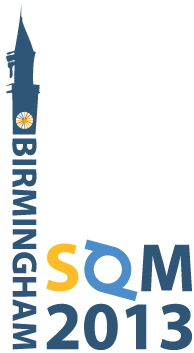Speaker
Ms
Sabita Das
(Brookhaven National Laboratory, USA and Institute of Physics, India)
Description
The STAR experiment at RHIC has collected data at various collision
energies in its beam energy scan (BES) program to study
the QCD phase diagram. The BES program covers a large part of the QCD
phase diagram in terms of temperature (T) versus baryon chemical
potential ($\mu_B$). The collected data set can be used to study the
kinetic and chemical freeze-out dynamics. The kinetic and chemical freeze-out parameters can be extracted using the transverse momentum ($p_{T}$) spectra of hadrons and the total yields within the framework of statistical model assuming thermal equilibrium.
We report the centrality and energy dependence of chemical freeze-out parameters (temperature, baryon and strangeness chemical potential, and strangeness saturation factor) in Au+Au collisions at $\sqrt{s_{NN}} =$ 7.7, 11.5, 27, and 39 GeV. The chemical freeze-out conditions are obtained by comparing the experimentally measured ratios of particle yields at mid-rapidity, which includes $\pi^{\pm}$, $\emph{K}^{\pm}$, $\emph{p}$, $\bar{\emph{p}}$, $K^{0}_{S}$, $\Lambda$, $\bar{\Lambda}$, $\Xi^{-}$, and $\bar{\Xi^{+}}$ to those obtained from the statistical-thermal model calculations (THERMUS). The kinetic freeze-out parameters of temperature and radial collective flow are obtained by fitting the invariant pT differential yields of the produced hadrons, as a function of transverse momentum using a Blast Wave model.
Author
Ms
Sabita Das
(Brookhaven National Laboratory, USA and Institute of Physics, India)
